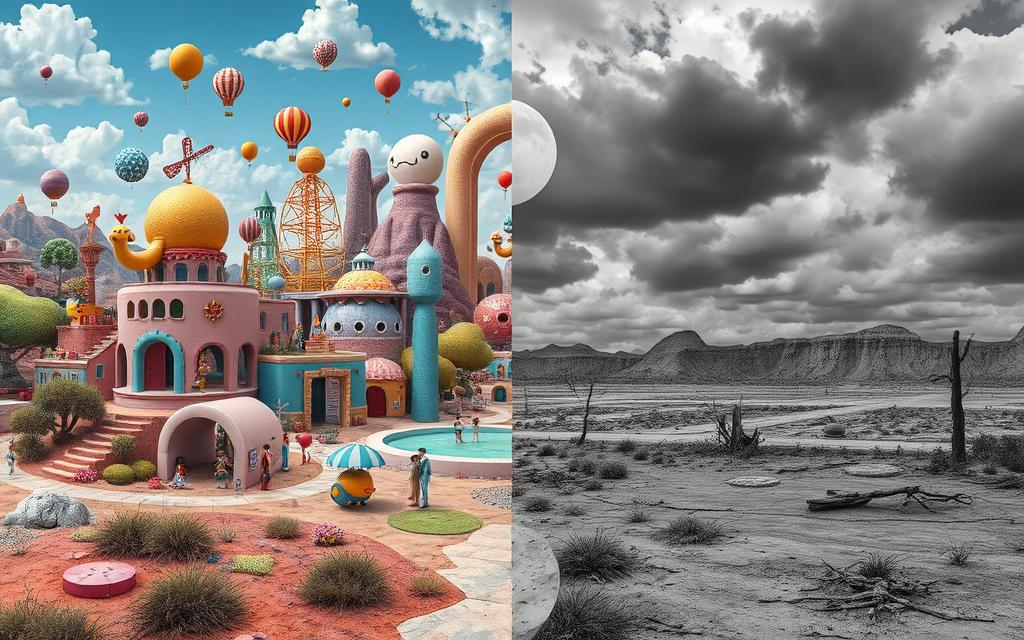As I sipped my morning coffee, I thought about a big question: is perception everything? We often hear “perception is reality,” but is that true? Perception and reality are different, and knowing the difference is key to understanding our world.
Our perception is influenced by many things – our past, biases, feelings, and senses. It’s how we see the world. But, this view can change what’s real, making us make choices and believe things that might not be true.
Let’s dive deeper into this topic. Join me as we look at how perception and reality differ, the impact of perception on our actions, and how to understand people better.
The Disconnect Between Perception and Reality
Life is complex, and understanding the difference between perception and reality is key. Perception is what we think something is like. Reality is what actually exists, not affected by our thoughts. This gap between what we see and the real world shapes how we see the world.
Exploring the Definitions of Perception and Reality
Perception is shaped by our senses and past experiences. It’s how we see the world, colored by our biases and what we expect. Reality, however, is the true state of things, not influenced by us. It follows its own rules.
Definitions highlight the big difference. Perception is what we think, while reality is the real world. Mixing them up means we give up on understanding the true world. This can make us lose sight of the objective truth in our subjective experiences.
| Perception | Reality |
|---|---|
| Mental impression or interpretation | The world or state of things as they actually exist |
| Subjective experience | Objective truth |
| Influenced by senses, biases, and frames of reference | Independent of our minds and perceptions |
“Perception is reality” is a dangerous idea. It can make us see the world wrongly and our place in it.
Understanding the complex relationship between perception and reality is crucial for growth. It helps us see the world more clearly. By seeing the gap between them, we can work towards a deeper understanding of the objective truth behind our subjective experiences.
Perception: The Genesis of Our Worldview
Our perception shapes how we see the world. It’s like a lens that helps us make sense of reality. But, we often think our view of the world is the real deal. This isn’t always true.
Many things affect our perception, like our genes, past experiences, and feelings. These factors shape our beliefs and the world we see, making a gap between what we think and reality.
Think about it – everyone sees the world differently, based on their own life and views. What one person sees as true might not be the same for another. This is because their view has been shaped by different things.
“The world we have created is a product of our thinking; it cannot be changed without changing our thinking.” – Albert Einstein
This quote shows how our perception shapes our view of the world. To really get to know reality, we need to understand our own biased views. By doing this, we can close the gap between what we think and the real world.
Knowing how perception affects our reality helps us see the world more clearly. This self-awareness is key to matching our perception versus reality. It opens up the potential of our shared human experience.
The Power of Perception over Reality
Our view of the world often takes over from the real facts. Even if what we see doesn’t match the facts, it still affects how we act and interact. This mix of how we see things and the real world helps us understand ourselves better.
How Perception Guides Our Behavior
Our own view of the world, influenced by our biases and distorted thoughts, changes how we act and make decisions. For example, if we think we feel an itch, we might scratch it, even if there’s no actual itch. Here, our perception of the itch, not the reality, makes us act.
This shows how perception can shape our behavior, often in ways that don’t match the reality. Knowing this can help us understand how we make decisions and how our own feelings affect our actions, both on purpose and by accident.
| Perception | Reality | Behavioral Impact |
|---|---|---|
| Perceiving a threat in a harmless situation | The situation is objectively safe | Exhibiting a heightened stress response and defensive behaviors |
| Believing that a task is too difficult to complete | The task is within one’s capabilities | Avoiding the task or giving up prematurely |
| Feeling that a relationship is strained or disconnected | The relationship is healthy and supportive | Withdrawing from the relationship or exhibiting defensive behaviors |
Looking at how perception and behavior work together helps us understand our thoughts and actions better. It shows us how our own views shape our experiences and actions in the world.
“The world as we see it is not the world as it is, but rather the world as we are.” – Stephen R. Covey
perception versus reality

The saying “perception is reality” is often used wrongly. It suggests that what we think is true is the only truth. But perception and reality are different. Perception is what we think, while reality is the real truth that exists by itself.
In today’s fast, image-filled world, it’s easy to mix up what we see with reality. We see perfect lives on social media, ads, and news that aren’t always true. But growing and being happy comes from knowing the difference between perception versus reality. This helps us act and believe in line with the real truth.
“The world as we have created it is a process of our thinking. It cannot be changed without changing our thinking.” – Albert Einstein
Understanding the difference between perception and reality helps us control our stories and live by our values and dreams. This way, we don’t fall for the illusion versus reality that society shows us. It helps us make better choices, connect truly, and find real meaning in life.
Knowing the difference between perception and objective truth is key to growing and being fulfilled. It lets us shift our perspectives, define success for ourselves, and live the meaningful life we want.
Misaligned Perceptions in the Workplace
In the world of work, seeing things versus reality can be tricky. I’ve seen how wrong views can split managers and their teams. The perception versus reality issue is common in workplace dynamics. Here, communication and expectations often don’t match.
Imagine a manager gives clear instructions, but an employee sees them differently. This leads to not meeting the manager’s expectations. The issue is that the employee’s view of the instructions doesn’t match what the manager meant.
Bridging the Manager-Employee Perception Gap
Good communication helps close the perception gap between managers and employees. By listening well, asking for clarification, and making sure everyone understands, we can prevent misunderstandings. This makes work better for everyone.
| Perception | Reality |
|---|---|
| Managers expect employees to read their minds | Managers need to communicate clearly and set realistic expectations |
| Employees feel micromanaged and lack autonomy | Managers aim to provide guidance and support, not control every step |
| Managers are too focused on metrics and KPIs | Managers need to balance performance goals with employee well-being |
By fixing these wrong views, we can make our workplace relationships better. This leads to a culture of understanding and respect for each other.
The Principles of Human Understanding

In “The Cure for Stupidity: Using Brain Science to Explain Irrational Behavior at Work,” the author shares a powerful way to talk to people. This method, called the Principles of Human Understanding, gives us 22 tools to understand others better. It helps us see why people act and decide the way they do.
These principles are grouped into four areas: Observation, Orientation, Decision, and Action. They help us understand the gap between what we think and what really is. By using these insights, we can get to know ourselves and others better. This leads to better conversations and actions.
Observation Trap Principles
- Attention Blindness: We often miss the obvious because we’re looking for something specific.
- Confirmation Bias: We look for information that supports what we already believe.
- Anchoring Bias: The first information we get can greatly affect our decisions.
Orientation Trap Principles
- Framing Effect: How a choice is presented can change how we make decisions.
- Availability Heuristic: We think an event is more likely if we easily remember similar events.
- Sunk Cost Fallacy: We keep investing in something just because we’ve already spent money on it.
Knowing these principles and the cognitive biases behind them helps us make better choices. It helps us see the difference between what we think and what really is. This way, we can avoid making poor decisions and behave better.
| Principle | Description | Example |
|---|---|---|
| Attention Blindness | Not noticing the obvious because we’re focused on something else | Missing a gorilla in a crowd while counting basketball passes |
| Confirmation Bias | Interpreting information to fit what we already believe | Looking for news that supports our political views and ignoring the rest |
| Anchoring Bias | Being influenced by the first information we hear | Thinking a house is worth a certain price just because that’s the first price we hear |
Learning the Principles of Human Understanding helps us deal with the complex mix of perception versus reality. It helps us fight our natural cognitive biases. This way, we can communicate and behave better with others.
Brand Management: Shaping Perceptions
In the business world, how people see a company or product is crucial. It can make or break its success. As a professional copywriting journalist, I know how important brand management is. It shapes these perceptions from the start and throughout a business’s life.
Being consistent is key in brand management. Everything a company does, from its website to social media, must match its mission and vision. This makes sure what people think of the company matches what it actually offers.
Providing excellent and responsive customer service is a great way to manage brand perception. By giving customers a great experience, companies can gain trust and loyalty. This is key for perception versus reality in the market.
| Key Elements of Effective Brand Management | Benefits of Aligning Perception and Reality |
|---|---|
|
|
Effective brand management means making sure what people think matches what a company offers. By always delivering on promises and giving great customer service, companies can build a strong, positive reputation. This lasts in the minds of their clients.
“In a world filled with perceptions, the truth often gets lost in translation. Effective brand management is the bridge that connects reality to the minds of our customers.”
Bridging the Gap Between Perception and Reality
Understanding the difference between what we see and the true reality is key in today’s world. Often, our view of things differs from the real truth, causing a gap. To live in harmony with the world, we must match our views with reality.
Recognizing the impact of cognitive biases is a big step. These biases can change how we see the world, often in ways that aren’t true. By knowing about these biases, we can question our beliefs and aim for a clearer view.
Good communication helps close the gap between what we think and what is real. When talking with others, we should respect their views and be open to our own biases. By working together and understanding each other, we can make our shared view match the real world.
To bridge the gap, we need humility, curiosity, and a readiness to question our beliefs. By not taking our views for granted, listening to experts, and changing our opinions with new facts, we can better understand the world.
“The most dangerous thing in the world is the illusion of certainty.” – Emily Dickinson
| Perception | Reality |
|---|---|
| Our senses provide a complete and accurate representation of the external world. | Our senses are limited, and our brains fill in gaps to make sense of things. |
| We can rely on our intuitive judgments to make sound decisions. | Our instincts are often biased, leading to mistakes in judgment. |
| Our personal experiences and beliefs accurately reflect the broader societal consensus. | Our views can be shaped by many factors, making them different from what others see. |
Conclusion
At the end, we see that what we think and what really is are not the same. Our thoughts can be influenced by biases, making our perception different from reality. This gap can cause problems at both personal and societal levels.
Knowing the difference between what we see and the true state of things helps us make better choices. It’s important to base our views on facts, not just our feelings. This way, we can understand the world more clearly and work together better.
Let’s accept that what we think and what really is are not the same. Using this knowledge, we can make smarter choices, talk better, and build a better world for everyone.

